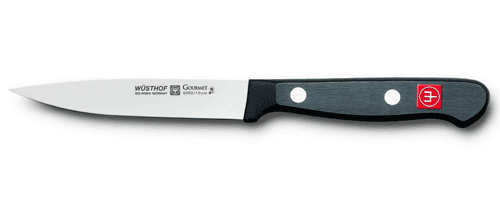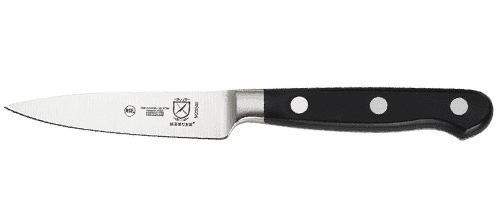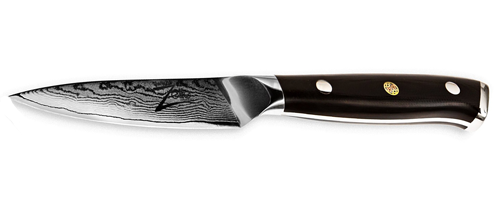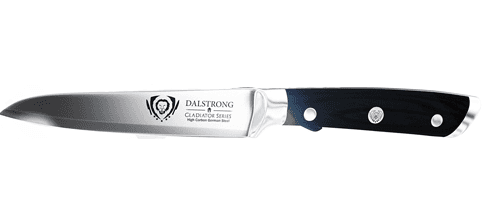Best Paring Knives: Complete Guide with Reviews
Buying knives can be stressful. There are so many options and it’s all too easy to end up with a kitchen that looks more like an armory. Sure, if you’re a butcher you’ll need a variety of different blades for all of your various meat chopping responsibilities. However, the average home chef doesn’t need to own enough knives that they could start a knife throwing league on the side. The truth of the matter is that the average kitchen really only needs a couple of knives. The knife industry obviously wants you to think otherwise, but do not fall for their trap.
After all, there’s a widespread agreement among chefs and culinary enthusiasts that you don’t necessarily need a large, extensive, and expensive set of kitchen knives. Instead, you’re better off investing in high quality versions of four types of knives: chef’s knife, serrated bread knife, boning knife, and paring knife. These four cover most of your basic food prep needs. As long as you have those four knives, you’ll be able to do just about anything in your kitchen.
Of course, the challenge is getting the right four knives to suit all your needs. That’s where we come in. Our knife experts have done the research and sampled all of the finest knives on the market. We know what you need and are here to ensure that you get the knives that you deserve. For now, let’s focus on the paring knife. In this guide, we’re going to highlight everything you need to know about paring knives so you can make an informed purchase and a paring knife that will last you decades. By the end of this article, you’ll be prepared to bring the perfect paring knife into your kitchen.
So, What Exactly Is a Paring Knife?
It’s probably best to start by answering this question, right? So what are paring knives? These small but versatile knives are a must0have for any kitchen, especially for dicing and mincing things that are a bit too small for your chef’s knife. For example, if you’re slicing strawberries, mincing garlic cloves, or chopping up fresh rosemary for a sous vide steak, then your paring knife is the ideal tool for the job.
Paring knives are usually around 3 ½” long. They are small and maneuverable. Their ever so slightly curved blade is ideal for a variety of kitchen tasks including peeling potatoes, chopping small vegetables, and coring tomatoes. These are tasks where a chef’s knife, your typical go-to knife for vegetable chopping, is too large and unwieldy. Even if you’re a fairly casual home cook, a paring knife is something you need to have. You’ll get a lot of use out of a good one, and like chef’s knives, it makes sense to invest a little more for a higher quality knife. After all, this is a knife that you’ll be using pretty much every day. You’ll want to make sure that it stays sharp and is built to last. This isn’t a knife that you’ll want to replace regularly. It’s far too valuable to your kitchen for that.
Types of Paring Knives
There are quite a few different styles of paring knife that you can find in stores and online. In general, they are all quite similar. They’re all similar in size, for example. The major differences between paring knives tends to lie in their shape. Here are a few of the most common and important example.
- Bird’s beak paring knives: Also known as trimming knives, these paring knives have a blade that’s concave. Chefs generally use these primarily for trimming and peeling.
- Classic paring knives: These are the kind of paring knife you’re most likely to get the most use out of. They tend to be the most versatile.
- Sheep’s foot paring knives: These knives have a flat blade edge and a rounded spine that is close to the tip.
When to Use a Paring Knife
Paring knives are great for smaller jobs where a chef’s knife seems too big, as well as for any situation where you’re holding the item you’re cutting, rather than resting it on a cutting board. You don’t always want to be wielding around a giant chef’s knife. Not only will it make certain tasks more difficult, it’s also fairly dangerous. So what are the best tasks to assign to your paring knife? Plenty, but here are just a few examples of relatively common kitchen tasks where a paring knife comes in handy.
- Coring tomatoes. Because they’re small and easy to maneuver, paring knives are perfect for coring a slippery tomato. Insert the knife about an inch or so into the tomato, and rotate it as you carve a full circle around the stem. Then, you can just lift out the core and discard it. Easy-peasy and impossible to achieve with a larger knife.
- Hulling strawberries. “Hulling” a strawberry means cutting off the green part at the top. This is one of those things where you’re working with a pretty small object, making a paring knife a more sensible choice than a chef’s knife. Angle the paring knife and cut slowly but firmly in a circular motion around the leaves. They’ll pop right off with ease, if done properly.
- Zesting citrus fruit. Lemon zest or lime zest is a great way to add a bit of acidity (not to mention the delicious taste of citrus!) to a variety of dishes. Paring knives are best if you’re cutting large pieces of zest from the peel, like you might use to rim a cocktail. You can really get in their with your hands and slice that peel right off.
- Peeling potatoes and sweet potatoes. Don’t have a potato peeler handy? You can use your handy paring knife instead. Sure, it might not be as efficient as a peeler, but you’ll still get far more control that you would with any other knife.
- Mincing garlic cloves. The small size of garlic cloves calls for a paring knife. Any larger knife would be just too much for this common kitchen task.
- Julienning carrots or celery. For most chopping tasks, you’ll find yourself defaulting to a chef’s knife. But for delicately julienning vegetables, paring knives work better. The delicate knife moves involved simply wouldn’t work with any other blade.
- Deveining shrimp. The tip of a paring knife is great for delicately removing the “vein” — which is really the digestive tract — from shrimp after peeling them. You’ll want to get that vein out before eating. No one likes their shrimp with a side of poo.
- Prepping bell peppers. A gentle once-over with a paring knife loosens and removes the seeds inside. Then, you can trim away the “ribs,” leaving the good and meaty part of the pepper. Trying to do this with a chef’s knife is like trying to do dentistry with a battle axe.
- Easing a cake or brownies out of the baking pan. Getting brownies or cakes out of the pan can be tough sometimes, even if you greased the pan properly. You can gently slide a paring knife around the edge of the cake to help ease it out without damaging it. An important tip for any bakers out there!
These are just a few examples of situations where you want to use a paring knife. Now you might be asking yourself another question: When shouldn’t you use a paring knife? Simply put, they’re not ideal for tougher vegetables, like celery root or parsnips, due to their light weight. Generally speaking, if you find yourself needing to press down hard or force the cut, the paring knife isn’t the right knife for the job. It’s too small for that. You’ll need a knife with more heft for that task.
Best Paring Knives
I’ve listed here my personal favorite paring knives, all of which contain riveted handles and high quality steel (most contain German steel). I use these paring knives regularly, especially during my sous vide cooking endeavors. You will absolutely be impressed with the quality of any of these paring knives!
1. Top Pick: Victorinox Paring Knife
With that said, Sous Vide Guy was less impressed with the quality of the handle. It feels remarkably light to hold, which for some may be a bonus. However we really do prefer a heavy handle with both a substantial tang and high-quality shelling around it.
The Victorinox Paring Knife comes in straight and serrated styles. An important distinction however is that within each category you can also choose the large handle or small handle style. Given some reports that the handles lack heft while excelling in sharpness Sous Vide Guy suggests going with the large handled option.
Pros
- Extremely sharp edge out of the box.
- Maintains this edge for several months for medium-high usage at the very least.
- Reputable brand.
Cons
- Handle and tang feel strangely light.
- Risk of knockoffs based on consumer reviews.
- Tang is unriveted and instead uses plastic shelling.
2. Runner Up: Wüsthof Classic Paring Knife
Pros
- Triple riveted tang.
- Forged high-carbon stainless steel.
- Dishwasher safe.
Cons
- Multiple consumers report faults in the blade leading to breaks months into use.
- Amazon knock-offs are common – make sure you’re getting the real deal!
3. Best German Steel: Mercer Culinary Renaissance 3.5-Inch Forged Paring Knife
Pros
- Thermoplastic handle with a triple riveted tang.
- High carbon German forged steel.
- Lifetime warranty.
Cons
- Not super sharp out of the box.
- Clamshell packaging design.
4. Best Japanese Style: ZELITE INFINITY Paring Knife
Pros
- Military grade thermoplastic handle with full triple riveted tang.
- Forged from AUS10 67-layer High Carbon Stainless Steel.
- Tempered in liquid nitrogen.
- Absolutely gorgeous Tsunami Rose Damascus pattern.
- Lifetime warranty dependent on location.
Cons
- Inconsistent sharpness out of the box. Make sure to do a test cut with a sheet of paper. If dull then sharpen.
- AUS10 steel is softer than German alternatives due to Japan’s lower-quality iron. This means maintenance will need to be much more regular.
5. Honorable Mention: DALSTRONG Gladiator Series Paring Knife
Pros
- Triple riveted tang.
- High-quality stainless steel with a long-lasting edge – multi-year in some cases.
- Good heft to the handle.
- Satin finished blade.
Cons
- Due to the 4-inch blade this knife is slightly more unwieldy than its 3.25 to 3.5 inch counterparts.
A Paring Knife is a Kitchen Essential
A paring knife, like a chef’s knife, is something every home cook needs to have. Ideal for smaller, more detailed tasks where a chef’s knife won’t do, paring knives are perfect for peeling, slicing, and dicing. No matter how casual you are about cooking at home, a paring knife is essential.
What to Look For in a Quality Paring Knife
Here’s what you should look for in a good paring knife for your home kitchen.
- A 3-3 ½” blade. Paring knives come in different sizes, but the three to three and a half inch range is the most versatile and multipurpose.
- A grip that feels comfortable in your hand. You don’t want the knife slipping out of your hands. Make sure the knife is comfortable to hold and use.
- An agile blade. By “agile,” we mean the tip is just a little bit flexible, and the knife can handle detail work with irregular shapes and curves.
- Full tang, riveted handles. Full tang handles often have 2-3 steel rivets in the handle so you know they are solid. Since paring knives are not used as a workhorse, full tang may not be 100% necessary, however it will surely last you years longer than a cheaper quality one.
To get a good paring knife, you’re usually looking at a price in the $20-40 range. They’re pretty affordable, and the mileage you’ll get out of a paring knife in the kitchen is more than worth the price.
FAQ
What is the best paring knife?
The big three in knife manufacturing when it comes to good to high quality blades are Wüsthof, J.A. Henckels, and Victorinox Swiss. All three offer a variety of blade lengths. They also sell much, much more than paring knives. If you’re looking to outfit your entire kitchen with knife-ware for all occasions then we would suggest looking into knife sets as well.
What is a paring knife used for?
Paring knives area prized for a combination of their razor-sharp edges and fine motor control. Working the blade of a paring knife allows for much more precise movements. This is particularly excellent when working with fruit, vegetables, or when preparing complex arrangements that require a high degree of knife skills. The ‘pare’ part of paring also refers to the act of trimming something precisely. As such it’s easy to see why sharpness and control are both associated with this style of blade.
What is the difference between a chef’s knife and a paring knife?
Chef’s knives are substantially longer than paring knives and tend to have much heavier handles. This additional weight allows for more precise control over the blade given its larger size. Chef’s knives also tend to have guards that allow the cook to rest their thumb and index figure against the blade itself. Again, this allows for much better knife control. You can also work with the entire length of the blade, which is designed for different styles of cutting using different parts of the knife. Paring knives are much more specialized tools on the other hand, and lack the wide-ranging functionality of chef’s knives. With that said pretty much every professional chef has both a paring knife and a traditional chef’s knife in their inventory (along with cleavers and a few other essentials like poultry shears).
How do you use a paring knife safely?
To use a paring knife safely you need to grip it firmly at the handle. Hold your food tightly in one hand, making sure to watch your fingers. Next work the blade toward your body while cutting as thinly as possible through your ingredients. Although this might sound a little risky human beings can control an inward pulling motion much more easily than an outward pushing motion. Moving the blade towards you while cutting rather than away allows for much more precise control, which is essential when working with such sharp implements.
Do paring knives need sharpening?
Absolutely! Although some of the knives on our list, like the Victorinox, maintain and edge for a long time we still suggest being diligent about sharpening. Professional cooks – line or otherwise – often sharpen their knives daily if not more regularly. Knifes lose their edge through their use. Therefore the more you use your knives the more important it becomes to be familiar with sharpening techniques.
How do you sharpen a pairing knife?
Sous Vide Guy always recommends using a sharpening stone when working on your knives. Remember that whetstones need to be soaked in water for 10-15 minutes before you begin working on the edge. To use a whetstone properly make sure to gently and evenly pull the blade towards yourself while alternating sides. Keep an eye out for any burs or warps in the blade. If the water on top of the whetstone is getting dirty with metal shavings then you know you’re on the right track!





